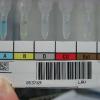Dansket
Members - Bounced Email
-
Joined
-
Last visited
-
Country
United States
-
-
-
-
-
-
-
-
-
-
-
-
-
Direct entry of manual testing results into LIS
We put a specimen number barcode on all gel cards for manual testing. When we migrated to ProVue, we put a specimen number barcode on the instrument print-out (single patient per page). For donor unit verification testing, we put DIN barcode labels next to each unit test result. Results were entered into Meditech using the single patient result entry program, same for donor units. NO SPREADSHEET ENTRY!
-
Ortho Vision CAP Specimens
- Ortho Vision CAP Specimens
Why aren't you using the CAP Survey specifically designed for automated instruments? I believe it is CAP-J.- Titre Value
We use a titer value of 0 (zero) to indicate absence of agglutination or less than 1+ agglutination in any tube.- gel diluent qc
I meant MTS Dil 2 and MTS Dil 2+.- gel diluent qc
On ProVue, there a two diluents, MTS Dil 1 and MTS Dil 2. These are controlled by running a positive and negative antibody screen test and a positive and negative Anti-IgG DAT test.- 2nd ABO
We also require that when second venipuncture is done, that the BB number is affixed to or written on the draw tube container label for ABO verification. On receipt of specimen container in BB, the number is entered into the BB computer (same screen as used to enter 2nd ABO verification test results) and computer- compared (custom code in Meditech) to the number on the original specimen used for the Type and Screen.- Rh negative Patients that receive Rh positive blood
See this large study https://www.ncbi.nlm.nih.gov/pubmed/3137672 regarding use of rh positive blood for untyped trauma recipients. Abstract The emergency blood needs of 449 patients were met by supplying 1,717 uncrossmatched units of either red blood cells (RBC) type specific Whole Blood or group O RBC. The RBC were all Rh positive, and 601 units were transfused to 262 untyped patients. None of the patients presented with anti-Rh antibodies. Only 20 patients who were Rh negative received group O Rh positive RBC, and most of these patients were male. There were no acute hemolytic reactions or sensitizations of young females. Group O Rh positive RBC is our first choice to support patients with trauma who cannot wait for type specific or crossmatched blood. Those who do survive the emergency conditions can be reverted to blood of their own type without problem. Acceptance of Rh positive emergency transfusions by physicians giving emergency care can prevent unbalanced shortages in a regional blood supply system.- Performing Antibody Screens As Part of RhIG Workups
Are you inspected by the AABB?- positive dat w cord blood
- BloodBankTalk: Antibody/Antigen Reaction
I just answered this question. My Score FAIL- BloodBankTalk: Antibody/Antigen Reaction
I just answered this question. My Score PASS- Performing Antibody Screens As Part of RhIG Workups
Over the decades since Rh Immune Globulin became available and a standard for care in 1968, the guiding principle changed from 'looking for reasons not to give', i.e. withholding the injection versus currently 'looking for reasons to give'. Initially, the injection vial was packaged with a crossmatch vial that required a test tube crossmatch with the patient's rbcs. This was a safety step to address the concern of giving such a large volume (at that time I think it was 5ml in the US) of anti-D to an Rh positive individual. Much later, it was determined that a second injection was required around 28 wks to prevent sensitization of women who might be hyper-responders. Those safety concerns have been addressed with low volume (0.7ml), low protein formulations. Crossmatching is no longer required. Performing an antibody screen with a workup is consistent with the original philosophy of 'looking for reasons to withhold the injection'.- Typenex Bands: Should They Stay or Should they Go?
We trained Nursing that the Typenex band was the only means of identifying a transfusion recipient. That statement was preprinted on the compatibility tag attached to the blood container and had to be signed by two Nursing personnel. Nursing was instructed that If a mismatch between letter-number code on Typenex band and the Typenex label on the compatibility tag was detected, do not transfuse regardless of any other band on the patient.- Typenex Bands: Should They Stay or Should they Go?
You might consider offering an alternative to the Typenex bands that would satisfy both sides by offering an electronic system that mimics the rationale for the Typenex system. The current Typenex system is based the use of bar coded blood sample container labels that can only be sourced from the patient identification band. An electronic mimic of Typenex can be used for identification and labeling of all laboratory specimen containers. - Ortho Vision CAP Specimens
Important Information
We have placed cookies on your device to help make this website better. You can adjust your cookie settings, otherwise we'll assume you're okay to continue.

